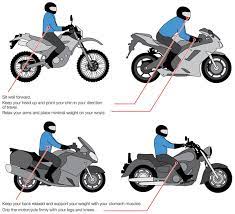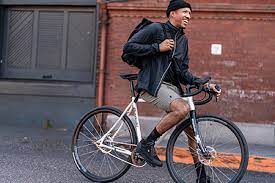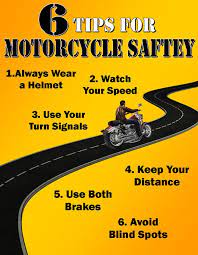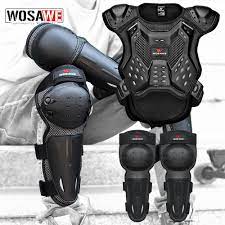
Motorcycle Riding Techniques: Mastering the Art of Two-Wheel Control
Motorcycle riding is not just about hopping on a bike and hitting the road. It requires skill, precision, and a deep understanding of various riding techniques. Whether you are a seasoned rider or a beginner, honing your riding skills is essential for both safety and enjoyment on the road. In this article, we will delve into some fundamental motorcycle riding techniques that every rider should know.
Body Positioning:
Proper body positioning is crucial for maintaining balance and control while riding. When cornering, shift your body weight towards the inside of the turn by leaning slightly in that direction. Keep your upper body relaxed and look through the turn to where you want to go. This technique helps maintain stability and allows for smoother cornering.
Braking:
Knowing how to brake effectively can be a lifesaver in critical situations. Use both brakes simultaneously, applying gradual pressure rather than grabbing them abruptly. The front brake provides most of the stopping power, so use it with care but don’t be afraid to utilize it when needed. Remember to progressively release the brakes as you come to a stop to prevent skidding.
Cornering:
Mastering cornering techniques is essential for navigating curves with confidence. Approach corners at an appropriate speed, gradually decelerating if necessary before entering the turn. Lean your body into the corner while keeping your eyes focused on the exit point of the curve. Apply smooth throttle control throughout the turn to maintain stability.
Countersteering:
Countersteering may seem counterintuitive at first but is an important technique for initiating turns at higher speeds or in emergency situations. To execute countersteering, push forward on the handlebar in the direction opposite to where you want to go (e.g., pushing right to initiate a left turn). This slight input causes the bike’s dynamics to lean into the desired direction.
Slow-speed Maneuvering:
Navigating tight spaces or performing U-turns at low speeds can be challenging. Practice clutch control and throttle modulation to maintain a smooth and steady pace. Keep your head up, look in the direction you want to go, and use your body weight to balance the bike. Feather the clutch and apply light rear brake control to maintain stability.
Situational Awareness:
Being aware of your surroundings is crucial for safe riding. Constantly scan the road ahead, checking for potential hazards, traffic patterns, and road conditions. Maintain a safe following distance from other vehicles, anticipate their movements, and always be prepared to react accordingly.
Remember that mastering these techniques takes practice, patience, and experience. Start by honing your skills in controlled environments such as empty parking lots or designated training areas before taking them out onto the open road. Consider enrolling in a motorcycle safety course to receive professional guidance and instruction.
Lastly, always wear appropriate safety gear including a helmet, gloves, jacket, boots, and pants designed for motorcycling. These protective measures can greatly reduce the risk of injury in case of an accident.
In conclusion, understanding and practicing these fundamental motorcycle riding techniques will enhance your control over the bike while ensuring a safer and more enjoyable riding experience. So gear up, get on your bike, and embark on a journey towards mastering the art of two-wheel control!
7 Essential Motorcycle Riding Tips: Mastering Techniques for a Safe Journey
- Wear the right protective gear – Always make sure you wear a helmet, gloves, boots and protective clothing when riding your motorcycle.
- Know your bike – Familiarise yourself with the controls of your bike before setting off on a journey.
- Take it easy – Don’t ride too fast or take risks that could put you in danger.
- Check your brakes – Make sure that the brakes are functioning properly before heading out on any ride.
- Be aware of other road users – Look out for other vehicles, pedestrians and cyclists when driving, especially at junctions and roundabouts.
- Follow the rules of the road – Stick to speed limits, use indicators when turning and always give way to traffic from side roads where necessary.
- Stay alert – Concentrate on what’s happening around you at all times while riding so that you can react quickly if needed
Wear the right protective gear – Always make sure you wear a helmet, gloves, boots and protective clothing when riding your motorcycle.
Wear the Right Protective Gear: Safeguarding Yourself on Two Wheels
When it comes to motorcycle riding, safety should always be a top priority. One crucial aspect of staying safe on the road is wearing the right protective gear. No matter how experienced you are as a rider, accidents can happen, and having the proper gear can make all the difference.
The most essential piece of protective equipment for any rider is a helmet. It’s not just a legal requirement in many countries; it’s a vital safeguard for your head and brain. Make sure your helmet meets safety standards and fits snugly on your head. A well-fitted helmet can protect you from head injuries and potentially save your life in case of an accident.
Gloves are another crucial piece of gear that should never be overlooked. They not only provide protection for your hands but also enhance your grip on the handlebars. Look for gloves made from durable materials with extra padding in key areas like palms and knuckles. Not only will they shield your hands from potential injuries in case of a fall, but they also provide added comfort during long rides.
Proper footwear is essential for maintaining control and protecting your feet and ankles while riding. Invest in sturdy boots that cover your ankles and have non-slip soles to ensure a firm grip on the footpegs or ground when stopping. Good motorcycle boots offer protection against impact, abrasion, and even weather conditions.
Donning protective clothing is equally important when it comes to motorcycle safety. Wearing long pants and a jacket made from durable materials such as leather or abrasion-resistant textiles adds an extra layer of protection against road rash in case of a slide or fall. Look for jackets with built-in armor or reinforced padding at critical areas like elbows, shoulders, and back.
Remember, wearing the right protective gear isn’t just about complying with regulations; it’s about safeguarding yourself against potential risks on the road. Accidents can happen unexpectedly, and having the right gear significantly reduces the severity of injuries.
So, before you hop on your motorcycle, take a moment to ensure you are properly equipped. Wear a helmet that fits well, gloves that provide grip and protection, boots that support your feet, and clothing that shields your body. By doing so, you’ll not only ride in style but also with confidence knowing that you’ve taken important steps to protect yourself.
Ride safe, ride smart, and always wear the right protective gear – because your safety matters!
Know your bike – Familiarise yourself with the controls of your bike before setting off on a journey.
Know Your Bike: Mastering Motorcycle Controls for a Safe Journey
Before embarking on any motorcycle journey, it is crucial to familiarize yourself with the controls of your bike. Knowing how to operate each component and understanding its function will not only enhance your riding experience but also contribute to your safety on the road. In this article, we emphasize the importance of getting to know your bike before setting off on any adventure.
The Handlebars:
Start by familiarizing yourself with the handlebars. Understand the location and operation of the throttle, which controls the speed of your bike. Get a feel for the front brake lever, located on the right handlebar, which provides stopping power. On the left handlebar, locate and practice using the clutch lever, essential for shifting gears smoothly.
The Foot Controls:
Next, focus on the foot controls. Locate and learn how to operate the gear shifter lever with your left foot. Familiarize yourself with finding neutral and smoothly shifting up or down gears while keeping control of your bike. Additionally, understand how to use both brakes effectively – apply pressure to the rear brake pedal with your right foot and use your toes or ball of your foot for gear shifting.
Instrument Panel:
Take a moment to study your bike’s instrument panel. Understand what each gauge or indicator represents – speedometer, odometer, fuel gauge, engine temperature gauge – and their respective warning lights. Being aware of these readings will help you monitor important aspects of your bike’s performance during your journey.
Lights and Signals:
Ensure you know how to operate all lighting features on your motorcycle. Familiarize yourself with switching between high beam and low beam headlights as well as activating indicators for turning or changing lanes. Properly functioning lights are essential for visibility on the road and signaling intentions to other drivers.
Emergency Shut-off:
Lastly, locate the emergency shut-off switch, typically found near the handlebars. Understanding how to quickly turn off your bike in case of an emergency or when needing to stop abruptly is crucial for your safety.
By taking the time to familiarize yourself with these essential controls and features, you will gain confidence and control over your bike. Practice operating them in a safe environment before embarking on any journey, ensuring that you can react instinctively and effectively while on the road.
Remember, each motorcycle may have slight variations in controls and features, so consult your bike’s owner manual for specific details. Additionally, if you are new to motorcycling or need a refresher, consider enrolling in a motorcycle training course to receive professional guidance on bike controls and safe riding practices.
Knowing your bike inside out is not only a matter of convenience but also a vital aspect of rider safety. So before you hit the road, take the time to familiarize yourself with every control and feature of your motorcycle. It’s an investment that will pay off for years of enjoyable and safe riding ahead.
Take it easy – Don’t ride too fast or take risks that could put you in danger.
Take it Easy: Prioritizing Safety in Motorcycle Riding
When it comes to motorcycle riding, there’s an undeniable allure to the feeling of freedom and exhilaration on the open road. However, it’s crucial to remember that safety should always be the top priority. One important tip that every rider should keep in mind is to take it easy – don’t ride too fast or take risks that could put you in danger.
Speed can be tempting, especially when you’re on a powerful machine that begs to be unleashed. But riding at excessive speeds greatly increases the likelihood of accidents and reduces your ability to react to unexpected situations on the road. It’s essential to respect speed limits and adjust your riding style according to the conditions and traffic around you.
Riding within your limits not only keeps you safe but also allows you to have better control over your bike. When pushing beyond your comfort zone, you risk losing control and compromising your safety. Remember, it’s not a race; it’s about enjoying the ride while being mindful of potential hazards.
Additionally, taking unnecessary risks can have severe consequences. Riding recklessly by weaving through traffic, tailgating other vehicles, or performing stunts puts not only yourself but also others at risk. It’s crucial to ride defensively and anticipate potential dangers instead of actively seeking out risky maneuvers.
By adopting a responsible approach to riding, you’ll not only protect yourself but also contribute to creating a safer environment for all road users. Respect traffic laws, give yourself enough time and space for maneuvering, and always maintain a defensive mindset.
Taking it easy doesn’t mean sacrificing fun or excitement; rather, it means finding the right balance between enjoying the thrill of riding while prioritizing safety. By doing so, you can embark on countless memorable journeys with peace of mind.
So next time you hop on your motorcycle, remember this valuable tip: take it easy – don’t ride too fast or take risks that could put you in danger. Embrace the joy of riding responsibly, and let the road become your playground while keeping yourself and others safe.
Check your brakes – Make sure that the brakes are functioning properly before heading out on any ride.
Check Your Brakes: Ensuring Safety on Two Wheels
When it comes to motorcycle riding, one of the most critical aspects of safety is having properly functioning brakes. Before embarking on any ride, it is essential to check your brakes to ensure they are in optimal condition. In this article, we will emphasize the importance of brake maintenance and how it contributes to a safe and enjoyable riding experience.
Brakes play a vital role in controlling your motorcycle’s speed and stopping power. Regularly inspecting and maintaining them can prevent potential accidents caused by brake failure. Here are a few steps to follow when checking your brakes:
Visual Inspection:
Start by visually examining the brake pads or shoes. Look for signs of excessive wear, such as thinning or unevenness. If the pads are worn beyond their recommended thickness or if you notice any damage, they should be replaced immediately.
Brake Fluid Level:
Check the brake fluid reservoir to ensure that it is filled up to the recommended level. Low fluid levels can affect braking performance and may indicate a leak or other issues within the braking system.
Brake Lever or Pedal:
Engage the brake lever (for front brakes) or pedal (for rear brakes) and observe their responsiveness. They should feel firm and provide consistent resistance when applied. If they feel spongy, loose, or require excessive force to engage, there may be air in the brake lines or other problems that need attention.
Brake Lights:
Confirm that both your front and rear brake lights are working correctly. These lights are crucial for signaling your intentions to other road users when slowing down or coming to a stop.
Test Ride:
After performing these checks, take a short test ride in a safe area to verify that your brakes respond effectively under normal riding conditions. Pay attention to any unusual noises, vibrations, or inconsistencies during braking.
Remember, if you have any doubts about your ability to inspect or maintain your brakes, it is always recommended to consult a qualified mechanic or professional motorcycle technician. They possess the expertise and knowledge to diagnose and resolve any potential brake issues.
By regularly checking your brakes and addressing any problems promptly, you can ride with confidence, knowing that you have reliable stopping power when needed. Your safety and that of others on the road depend on it.
In conclusion, before embarking on any motorcycle ride, make it a habit to check your brakes thoroughly. This simple yet crucial step ensures that your braking system is in proper working order, providing you with the confidence and peace of mind for a safe and enjoyable journey. Stay vigilant, maintain your brakes, and keep the thrill of riding alive while prioritizing safety at all times.
Be aware of other road users – Look out for other vehicles, pedestrians and cyclists when driving, especially at junctions and roundabouts.
Motorcycle Riding Techniques: Be Aware of Other Road Users
When it comes to motorcycle riding, one of the most important tips to remember is to be aware of other road users. Being vigilant and keeping an eye out for vehicles, pedestrians, and cyclists is crucial for your safety and the safety of those around you. This is especially important at junctions and roundabouts where interactions with other road users are frequent.
As a motorcyclist, you have a smaller profile on the road compared to cars or trucks. This means that you may be less visible to other drivers. By actively looking out for other vehicles, pedestrians, and cyclists, you can anticipate their movements and take appropriate action to avoid potential collisions.
When approaching junctions or roundabouts, slow down and assess the situation before proceeding. Look left, right, and even behind you to ensure that there are no vehicles approaching from different directions. Keep an eye on pedestrians who may be crossing the road or using designated crossings.
Additionally, be mindful of cyclists who share the road with you. Give them enough space when overtaking and always check your blind spots before changing lanes or making turns. Cyclists can sometimes be unpredictable, so it’s essential to exercise caution when sharing the road with them.
Remember that being aware of other road users goes hand in hand with defensive riding techniques. Stay alert at all times, anticipate potential hazards, and maintain a safe distance from other vehicles. By doing so, you’ll have more time to react if something unexpected happens.
In conclusion, being aware of other road users is a fundamental aspect of motorcycle riding techniques. By looking out for vehicles, pedestrians, and cyclists at junctions and roundabouts, you can significantly reduce the risk of accidents and ensure a safer riding experience for everyone on the road. So keep your eyes peeled and ride defensively – it could make all the difference!
Follow the rules of the road – Stick to speed limits, use indicators when turning and always give way to traffic from side roads where necessary.
Follow the Rules of the Road: Ensuring Safety and Harmony on Two Wheels
When it comes to motorcycle riding, adhering to the rules of the road is not just a legal obligation, but also a crucial aspect of ensuring safety for yourself and others. Following speed limits, using indicators when turning, and giving way to traffic from side roads are essential practices that every rider should embrace.
One of the most basic rules to abide by is sticking to speed limits. Speed limits are in place for a reason – they help maintain control and reduce the risk of accidents. Excessive speed not only endangers your own life but also poses a threat to other road users. By respecting speed limits, you contribute to a safer and more harmonious traffic environment.
Using indicators when turning is another vital aspect of responsible riding. Indicators communicate your intentions to other road users and allow them to anticipate your next move. Whether you’re changing lanes or making a turn, activate your indicators in advance and ensure they are visible to others. This simple action promotes predictability on the road and minimizes the chances of collisions.
Additionally, always give way to traffic from side roads where necessary. Yielding right of way is not only courteous but also essential for preventing accidents at intersections or junctions. Be vigilant while approaching these areas, scan for any incoming traffic, and yield appropriately if required. Remember that being patient and allowing others their right of way can prevent potentially dangerous situations.
By following these fundamental rules of the road, you contribute towards creating a safer environment for all road users, including yourself. Motorcyclists often face unique risks due to their smaller size and visibility compared to other vehicles. Therefore, it becomes even more crucial for riders to be mindful of their actions and prioritize safety at all times.
Remember that as a motorcyclist, you represent not only yourself but also the wider community of riders. By setting an example through responsible riding practices, you help shape a positive perception of motorcyclists in the eyes of other road users. Let’s work together to foster a culture of safety, respect, and cooperation on our roads.
So, next time you hit the road on your motorcycle, remember to stick to speed limits, use indicators when turning, and always give way to traffic from side roads where necessary. By doing so, you contribute towards creating a safer riding experience for everyone while upholding the principles of responsible motorcycling.
Stay alert – Concentrate on what’s happening around you at all times while riding so that you can react quickly if needed
Stay Alert: The Key to Motorcycle Riding Safety
When it comes to motorcycle riding, staying alert is paramount. Concentrating on what’s happening around you at all times can make a significant difference in your safety on the road. By staying alert, you enhance your ability to react quickly and effectively to any unexpected situations that may arise.
As a motorcyclist, you are more vulnerable than other road users. Unlike drivers enclosed in cars, you lack the protection of a metal frame and airbags. Therefore, maintaining a high level of awareness is crucial for your well-being.
One of the first steps towards staying alert is minimizing distractions. Avoid using mobile phones or any other electronic devices while riding. These distractions divert your attention away from the road and increase the risk of accidents. Keep your focus solely on riding and be fully present in the moment.
Furthermore, constantly scanning your surroundings is vital for identifying potential hazards. Pay attention to vehicles ahead, behind, and beside you. Watch out for sudden lane changes, merging traffic, or pedestrians crossing the road. By being aware of your surroundings, you can anticipate potential risks and take necessary evasive actions promptly.
Another aspect of staying alert is being mindful of road conditions. Keep an eye out for potholes, loose gravel, wet surfaces, or any other obstacles that could affect your traction or stability. Adjust your speed accordingly and maintain a safe distance from vehicles in front of you to allow for ample reaction time.
Additionally, fatigue can significantly impair your ability to stay alert while riding. Long rides or riding for extended periods without breaks can lead to decreased concentration levels. Take regular rest breaks to refresh yourself and combat fatigue. Staying hydrated and nourished also plays a crucial role in maintaining mental alertness.
Remember that defensive riding goes hand in hand with staying alert. Assume that other road users may not see you or might not follow traffic rules correctly. Stay prepared to react defensively by positioning yourself appropriately on the road, using your signals effectively, and being ready to take evasive actions if necessary.
In conclusion, staying alert while riding is a fundamental aspect of motorcycle safety. By concentrating on what’s happening around you at all times, you can react quickly and effectively to any potential dangers. Minimize distractions, scan your surroundings, be mindful of road conditions, combat fatigue, and practice defensive riding. By doing so, you enhance your safety and the enjoyment of every ride you take. Stay alert and ride responsibly!





